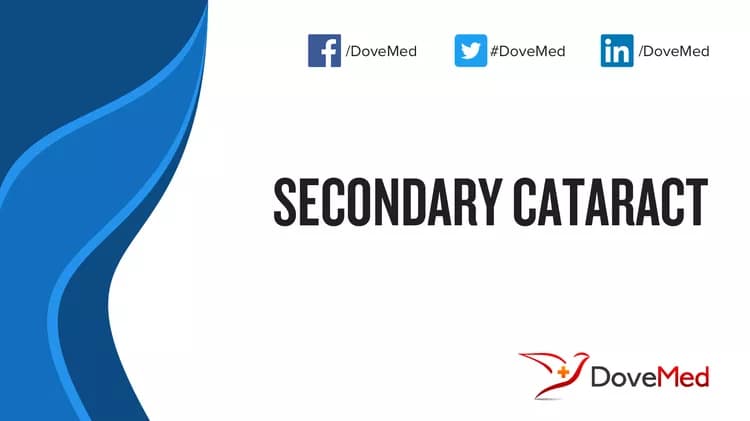What are the other Names for this Condition? (Also known as/Synonyms)
- After-Cataract
- PCO (Posterior Capsular Opacification)
- Posterior Capsular Opacification (PCO)
What is Secondary Cataract? (Definition/Background Information)
- Secondary Cataract, medically termed Posterior Capsular Opacification (PCO) or After-Cataract, is a common complication that can occur after cataract surgery. It involves the clouding of the posterior capsule of the lens (that holds the artificial intraocular lens, or IOL, in place), causing blurred vision and visual disturbances
- The signs and symptoms of Secondary Cataract may include blurred vision, glare, halos around lights, and difficulty with night vision. These symptoms can significantly impact an individual’s ability to see clearly. An eye specialist can diagnose this form of cataract during a routine eye examination. The visual acuity may be assessed, and a specialized instrument called a slit lamp is used to examine the back of the lens capsule
- The most common and effective treatment for Secondary Cataracts is a procedure called YAG laser capsulotomy. During this outpatient procedure, a laser is used to create an opening in the cloudy capsule, allowing light to pass through and restoring clear vision. YAG laser capsulotomy is a quick and painless procedure with a high success rate
- The prognosis for individuals with Secondary Cataracts is excellent. YAG laser capsulotomy is a safe and effective procedure that usually results in an immediate improvement in vision. Most individuals are able to resume their normal activities soon after the procedure. However, it is essential to continue regular eye check-ups to monitor overall eye health and address any other potential vision issues that may arise over time
Who gets Secondary Cataract? (Age and Sex Distribution)
- Secondary Cataracts can affect individuals of any age who have undergone cataract surgery. There is no specific age or gender predilection.
- The condition is observed across all racial and ethnic groups worldwide
What are the Risk Factors for Secondary Cataract? (Predisposing Factors)
The following factors can increase the risk of Secondary Cataract include:
- A younger age at the time of cataract surgery
- Certain pre-existing medical conditions, such as diabetes, a history of uveitis, and genetic susceptibility
It is important to note that having a risk factor does not mean that one will get the condition. A risk factor increases one’s chances of getting a condition compared to an individual without the risk factors. Some risk factors are more important than others.
Also, not having a risk factor does not mean that an individual will not get the condition. It is always important to discuss the effect of risk factors with your healthcare provider.
What are the Causes of Secondary Cataract? (Etiology)
Secondary Cataract is a common condition that can occur after cataract surgery. It is characterized by the clouding or thickening of the capsule that holds the artificial intraocular lens (IOL) in place.
- Secondary Cataracts develop due to the proliferation of lens epithelial cells left behind during cataract surgery
- These cells can migrate and multiply, causing the lens capsule to become cloudy and impeding the passage of light
- It can cause vision problems similar to those experienced before cataract surgery, such as blurred or hazy vision
What are the Signs and Symptoms of Secondary Cataract?
The common signs and symptoms of Secondary Cataract include:
- Gradual vision decline
- Glare sensitivity
- Halos around lights
- Decreased contrast sensitivity
These signs and symptoms may resemble those associated with the initial cataract diagnosis.
How is Secondary Cataract Diagnosed?
The diagnosis of Age-Related Cataracts may involve the following tests and exams:
- Physical examination and medical history evaluation (including history of cataract surgery)
- Eye examination by an ophthalmologist is necessary for diagnosing this form of cataract
- Other tests performed by the healthcare provider may include:
- Slit-lamp biomicroscopy
- Dilated eye exam (dilated fundus examination)
- Visual acuity test
Many clinical conditions may have similar signs and symptoms. Your healthcare provider may perform additional tests to rule out other clinical conditions to arrive at a definitive diagnosis.
What are the possible Complications of Secondary Cataract?
If left untreated, Secondary Cataracts can significantly affect vision, leading to reduced quality of life. However, the condition is treatable and usually not associated with pain or other serious complications.
How is Secondary Cataract Treated?
YAG laser capsulotomy is the standard treatment for Secondary Cataract. During this outpatient procedure, a laser is used to create a small opening in the cloudy lens capsule, restoring clear vision. The procedure is safe and minimally-invasive.
How can Secondary Cataract be Prevented?
While complete prevention is not always possible, reducing risk factors like inflammation and careful surgical techniques can help minimize the chances of developing Secondary Cataracts.
What is the Prognosis of Secondary Cataract? (Outcomes/Resolutions)
- The prognosis for Secondary Cataract is generally excellent with appropriate management
- YAG laser capsulotomy effectively restores vision in most cases, providing clear and improved visual function
Additional and Relevant Useful Information for Secondary Cataract:
- A cataract is defined as opacification (to become opaque) or clouding of the natural clear lens that results in visual problems, including blindness
The following resource link may help in better understanding cataracts:
Related Articles
Test Your Knowledge
Asked by users
Related Centers
Related Specialties
Related Physicians
Related Procedures
Related Resources
Join DoveHubs
and connect with fellow professionals


0 Comments
Please log in to post a comment.